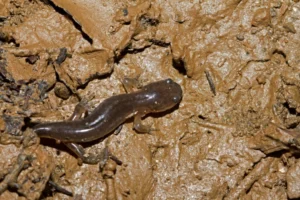Salamanders are quiet amphibians that often move slowly and stay hidden in damp, shady places. When you look at them, their wide, unblinking eyes are one of the first things you notice. You might wonder: do salamanders even have eyelids, and if not, how do they keep their eyes safe and moist?
Most salamanders do not have movable eyelids. Instead, a thin, clear layer called a spectacle covers their eyes. This layer shields their eyes from dirt and drying out, while still letting them see. A few species have small, partial eyelid-like folds, but blinking is not a normal behavior for salamanders.
How Salamander Eyes Are Built
Salamander eyes are large compared to their heads and sit on the sides, giving them a wide view of the world.

Each eye has several parts working together to support vision:
- The cornea, the outer layer, helps focus light.
- The lens sits behind the cornea and adjusts focus.
- The retina receives light and sends signals to the brain.
- The spectacle is a fixed, clear cover that replaces eyelids.
Because salamanders cannot blink, the spectacle stays in place all the time.
It acts like a shield, keeping their eyes clean and moist in the humid forests, streams, and ponds where they live.
Aquatic species also rely on the spectacle to reduce distortion underwater.
Without eyelids or tear ducts, salamanders depend on their surroundings to keep their eyes healthy.
Why Salamanders Do Not Blink
Blinking helps many animals moisten and protect their eyes. Salamanders, however, do not face the same challenges as creatures in dry, dusty, or windy places.
- Moisture: Their environments stay damp, so eye drying is rarely a problem.
- Shelter: Logs, leaves, and rocks give natural protection.
- Passive protection: The spectacle acts as a permanent barrier.
Because their habitats provide moisture and cover, salamanders lost the need for movable eyelids.

Their fixed spectacles became the simpler and more effective way to protect their vision.
Species With Partial Eyelids
A few salamanders have small folds above their eyes, but these cannot blink or fully close.
- Some mole salamanders show slight eyelid folds, but they do not move.
- These structures may provide shading or minor coverage, but they do not function like mammal or frog eyelids.
In most cases, partial eyelids are remnants of structures found in other amphibians.
They are minor adaptations, not active eyelid replacements.
How Salamanders Keep Their Eyes Moist
Since blinking is not an option, salamanders rely on moisture in their environment and their own bodies.
- High humidity: Keeps the spectacle from drying.
- Damp substrates: Hiding in wet leaves or soil helps maintain hydration.
- Skin absorption: Their skin takes in water, supporting the eyes and the rest of the body.
If you keep a salamander in a dry environment, its spectacle can become cloudy or irritated.
Providing moisture is essential to prevent eye problems.
How Salamanders Clean Their Eyes
Salamanders do not blink to clean their eyes. Instead, they use natural contact with water, surfaces, and mucus:
- Aquatic species swim through clean water, which rinses their eyes.
- Some rub their heads against surfaces, especially when shedding skin.
- Mucus helps prevent dirt from sticking to the spectacle.
Because their homes are usually free from dust, these passive methods are enough to keep their vision clear.
Eye Protection in Aquatic Salamanders
Salamanders that live in water have the most developed spectacles.
- Axolotls rely on their spectacle for full-time eye protection in freshwater.
- Hellbenders have broad heads and eyes covered by thick spectacles.

Water constantly hydrates their eyes and removes debris.
Clean water is especially important in captivity to avoid infections or irritation.
Why Salamanders Evolved This Way
Salamanders, frogs, and caecilians are all amphibians, but their eye adaptations differ.
- Frogs have movable eyelids and a third eyelid to protect against dust and sunlight.
- Salamanders stay hidden, often active at night in damp places. Blinking is unnecessary.
- Caecilians live underground and sometimes lack visible eyes altogether.
For salamanders, the spectacle is a simpler, more effective way to protect their eyes in quiet, moist habitats.
Do Salamanders Sleep With Their Eyes Open?
Salamanders cannot blink, so they appear to sleep with open eyes. Even so, they do rest:
- Lowering their heads or pressing them against surfaces
- Staying still for long periods
- Breathing more slowly
Their fixed spectacles do not stop them from having natural rest cycles.
Risks From Dryness and Poor Conditions
In the wild, salamanders rarely have eye problems. In captivity, however, improper care can cause issues:
- Dryness: Low humidity can irritate the spectacle.
- Infection: Dirty water or enclosures may cause bacterial or fungal problems.
- Cloudiness: Poor hydration can affect eye clarity.
Maintaining high humidity, clean water, and soft substrates keeps salamanders comfortable and their eyes healthy.
Conclusion
Most salamanders do not blink and do not have functional eyelids. A fixed, transparent spectacle protects their eyes, keeping them moist and safe.
Some species have partial eyelid folds, but full blinking is absent.
Their eye structure fits their quiet, slow-moving lifestyle, relying on moisture, shelter, and simple protective layers to keep vision clear.
Hi, my name is Ezra Mushala, i have been interested animals all my life. I am the main author and editor here at snakeinformer.com.

